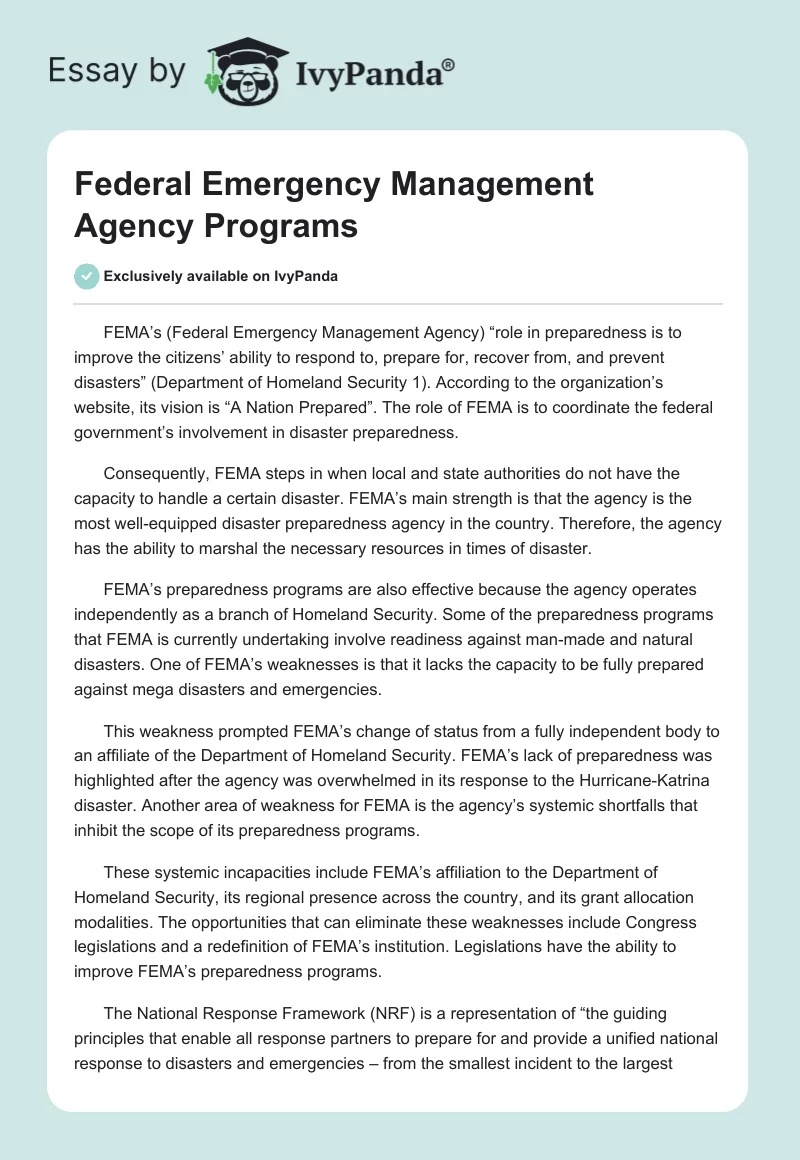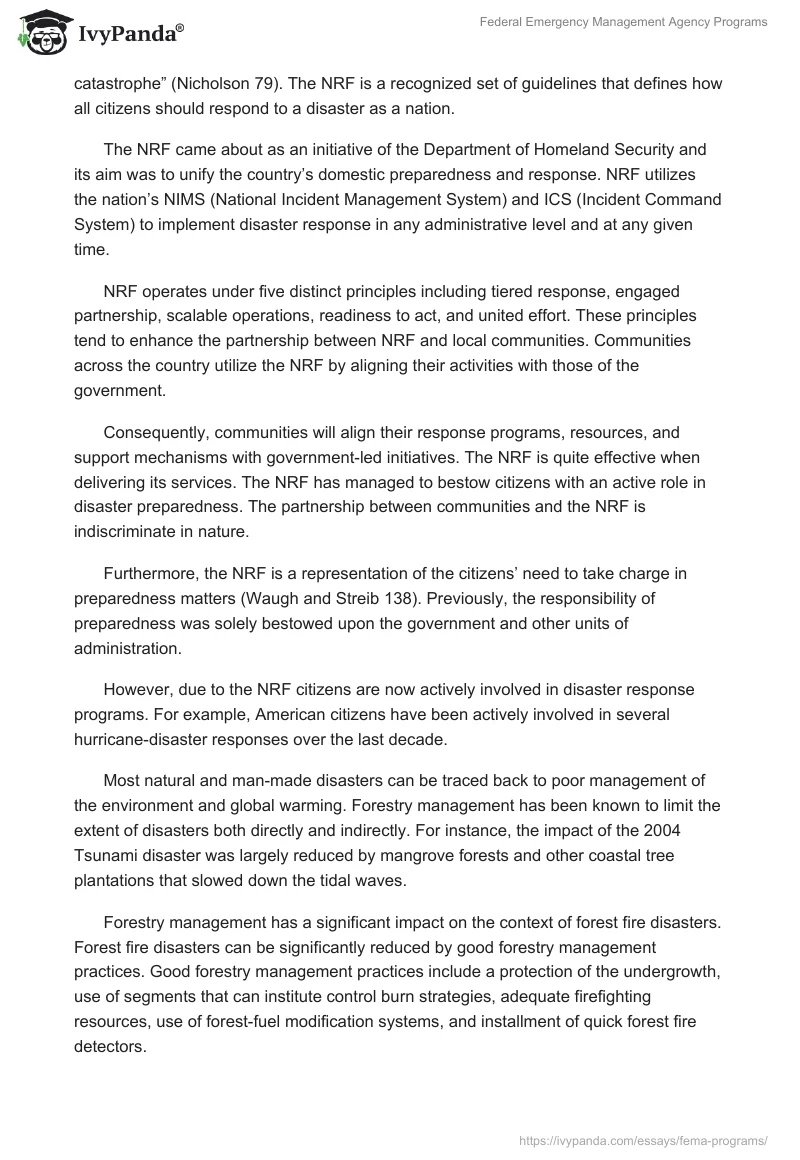FEMA’s (Federal Emergency Management Agency) “role in preparedness is to improve the citizens’ ability to respond to, prepare for, recover from, and prevent disasters” (Department of Homeland Security 1). According to the organization’s website, its vision is “A Nation Prepared”. The role of FEMA is to coordinate the federal government’s involvement in disaster preparedness.
Consequently, FEMA steps in when local and state authorities do not have the capacity to handle a certain disaster. FEMA’s main strength is that the agency is the most well-equipped disaster preparedness agency in the country. Therefore, the agency has the ability to marshal the necessary resources in times of disaster.
FEMA’s preparedness programs are also effective because the agency operates independently as a branch of Homeland Security. Some of the preparedness programs that FEMA is currently undertaking involve readiness against man-made and natural disasters. One of FEMA’s weaknesses is that it lacks the capacity to be fully prepared against mega disasters and emergencies.
This weakness prompted FEMA’s change of status from a fully independent body to an affiliate of the Department of Homeland Security. FEMA’s lack of preparedness was highlighted after the agency was overwhelmed in its response to the Hurricane-Katrina disaster. Another area of weakness for FEMA is the agency’s systemic shortfalls that inhibit the scope of its preparedness programs.
These systemic incapacities include FEMA’s affiliation to the Department of Homeland Security, its regional presence across the country, and its grant allocation modalities. The opportunities that can eliminate these weaknesses include Congress legislations and a redefinition of FEMA’s institution. Legislations have the ability to improve FEMA’s preparedness programs.
The National Response Framework (NRF) is a representation of “the guiding principles that enable all response partners to prepare for and provide a unified national response to disasters and emergencies – from the smallest incident to the largest catastrophe” (Nicholson 79). The NRF is a recognized set of guidelines that defines how all citizens should respond to a disaster as a nation.
The NRF came about as an initiative of the Department of Homeland Security and its aim was to unify the country’s domestic preparedness and response. NRF utilizes the nation’s NIMS (National Incident Management System) and ICS (Incident Command System) to implement disaster response in any administrative level and at any given time.
NRF operates under five distinct principles including tiered response, engaged partnership, scalable operations, readiness to act, and united effort. These principles tend to enhance the partnership between NRF and local communities. Communities across the country utilize the NRF by aligning their activities with those of the government.
Consequently, communities will align their response programs, resources, and support mechanisms with government-led initiatives. The NRF is quite effective when delivering its services. The NRF has managed to bestow citizens with an active role in disaster preparedness. The partnership between communities and the NRF is indiscriminate in nature.
Furthermore, the NRF is a representation of the citizens’ need to take charge in preparedness matters (Waugh and Streib 138). Previously, the responsibility of preparedness was solely bestowed upon the government and other units of administration.
However, due to the NRF citizens are now actively involved in disaster response programs. For example, American citizens have been actively involved in several hurricane-disaster responses over the last decade.
Most natural and man-made disasters can be traced back to poor management of the environment and global warming. Forestry management has been known to limit the extent of disasters both directly and indirectly. For instance, the impact of the 2004 Tsunami disaster was largely reduced by mangrove forests and other coastal tree plantations that slowed down the tidal waves.
Forestry management has a significant impact on the context of forest fire disasters. Forest fire disasters can be significantly reduced by good forestry management practices. Good forestry management practices include a protection of the undergrowth, use of segments that can institute control burn strategies, adequate firefighting resources, use of forest-fuel modification systems, and installment of quick forest fire detectors.
Communities that are afflicted by natural disasters such as Tsunamis, floods, and forest fires should take good forestry-management initiatives. Controlled burn is a strategy that is used to reduce the impact of fire disasters (Dale 730). Control burns are intentional man-made fires that are meant to reduce fuel for disastrous fires.
The advantages of the control burn strategy include its effective and inexpensive nature. However, controlled fires are disadvantageous because they are not always controllable and they can still end up being disastrous. Furthermore, control burn strategy is not environment-friendly.
Works Cited
Dale, Virginia. “Climate Change and Forest Disturbances.” BioScience 51.9 (2009): 723-734. Print.
Department of Homeland Security. Federal Emergency Management Agency. 01 Jun. 2014. Web. <https://www.fema.gov/>.
Nicholson, William. Emergency response and emergency management law: Cases and materials, New York, NY: Thomas, 2003. Print.
Waugh, William L., and Gregory Streib. “Collaboration and leadership for effective emergency management.” Public Administration Review 66.1 (2006): 131-140. Print.


